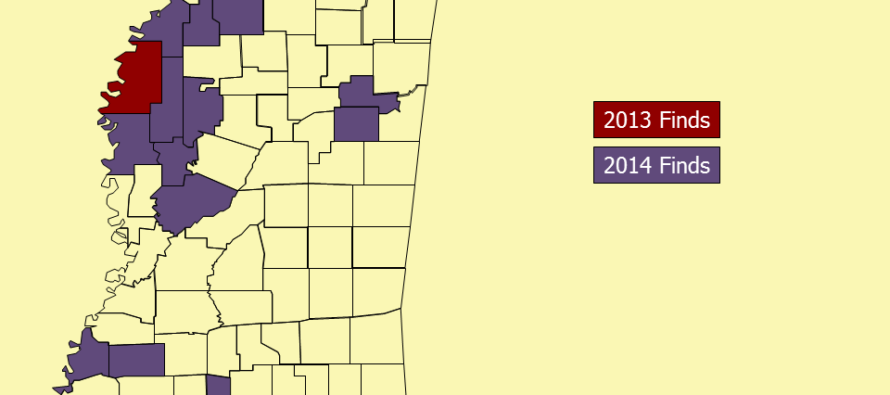Treating White Sugarcane Aphid: Decision Aid

White sugarcane aphids (WSCA) have been blowing up quickly to treatable levels in several counties in Mississippi. Over the last few days there have been several field requiring treatments with more likely coming. Because this is a new pest for Mississippi, we have been following the lead of our colleagues in Texas and Louisiana who dealt with this in 2013. Below are some criteria that we put together based on what we know to date that will help in making a decision to treat WSCA.
- WSCA’s are like any other aphid, it takes numbers to cause damage.
- Heavy infestations prior to head emergence can kill or stunt plants and reduce head size.
- Numbers have the potential to increase rapidly especially after a disruptive spray kills beneficial insects.
- WSCA’s can be a problem even until harvest and heavy populations cause harvesting problems.
- WSCA’s are hard to control. High rates of Lorsban (60 day PHI) and Transform seem to be the only real options at this time.
- Coverage is essential. Use 5 gallons of water by air and a minimum of 10 by ground.
- Manage expectations. Many WSCA’s can be low in the canopy and difficult to get sprays to.
- WSCA’s can blow back up after treatment and require another application.
- Using Dimethoate at 8 oz. or Lorsban at 16 oz. for midge may reduce the flare up.
- Lorsban cannot be applied by airplane in the state of Mississippi.
Transform Section 18 label Comments
- Foliar applications may be made by ground or air at a rate of 0.75-1.5 oz per acre. A maximum of 2 applications may be made per acre per year, resulting in a seasonal maximum application rate of 3.0 oz. of product per acre per year.
- The minimum application retreatment interval of 14 days and a restricted entry interval (REI) of 24 hours must be observed.
- A 7 day pre-harvest interval (PHI) for forage and a 14 day PHI for grain or stover must be observed.
- A maximum of 65,000 acres of sorghum fields (grain and forage) may be treated in Mississippi.
- This product is highly toxic to bees exposed through contact during spraying and while spray droplets are still wet. This product may be toxic to bees exposed to treated foliage for up to 3 hours following application. Toxicity is reduced when spray droplets are dry. Risk to managed bees and native pollinators from contact with pesticide spray or residues can be minimized when application are made before 7:00 pm local time or when the temperature is below 55 degrees F at the site of application.
- This specific exemption expires October 31, 2014.
Lorsban Label Comments
o Specific Use Instructions
- To minimize the potential for chemical injury, do not apply Lorsban 4E to drought stressed grain sorghum within 3 days following irrigation or rain except where the product is applied in irrigation water.
- Be aware that sorghum lines used in seed production fields may be more susceptible to chemical injury. Susceptible inbred lines or hybrids are likely to be at greater risk of yield reducing chemical injury when treated at the higher rates. Users should not apply more than 1 pint of Lorsban 4E per acre to seed sorghum if the additional risk of crop injury is unacceptable.
o Specific Use Instructions
- Preharvest Interval: Don not harvest for grain, forage, fodder, hay, or silage within 30 days after application of 1 pint of Lorsban 4E per acre or within 60 days after application rates above 1 pint per acre.
- Do not make more than 3 applications of Lorsban 4E or other products containing chlorpyrifos per use season.
- Maximum single application rate is 1 lb a.i. chlorpyrifos (2 pints of Lorsban 4E) per acre.
- Do not apply more than a total of 1.5 lb a.i. chlorpyrifos (3 pints of Lorsban 4E) per acre per season.
- Do not make a second application of Lorsban 4E or other products containing chlorpyrifos with 10 days of first application.
- Do not aerially apply this product in Mississippi
Write a comment
4 Comments
View comments







